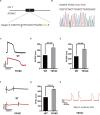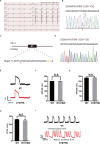Base Editing Mediated Generation of Point Mutations Into Human Pluripotent Stem Cells for Modeling Disease
- PMID: 33102492
- PMCID: PMC7546412
- DOI: 10.3389/fcell.2020.590581
Base Editing Mediated Generation of Point Mutations Into Human Pluripotent Stem Cells for Modeling Disease
Abstract
Human pluripotent stem cells (hPSCs) are a powerful platform for disease modeling and drug discovery. However, the introduction of known pathogenic mutations into hPSCs is a time-consuming and labor-intensive process. Base editing is a newly developed technology that enables facile introduction of point mutations into specific loci within the genome of living cells. Here, we design an all-in-one episomal vector that expresses a single guide RNA (sgRNA) with an adenine base editor (ABE) or a cytosine base editor (CBE). Both ABE and CBE can efficiently introduce mutations into cells, A-to-G and C-to-T, respectively. We introduce disease-specific mutations of long QT syndrome into hPSCs to model LQT1, LQT2, and LQT3. Electrophysiological analysis of hPSC-derived cardiomyocytes (hPSC-CMs) using multi-electrode arrays (MEAs) reveals that edited hPSC-CMs display significant increases in duration of the action potential. Finally, we introduce the novel Brugada syndrome-associated mutation into hPSCs, demonstrating that this mutation can cause abnormal electrophysiology. Our study demonstrates that episomal encoded base editors (epi-BEs) can efficiently generate mutation-specific disease hPSC models.
Keywords: Brugada syndrome; IPS; base editing; disease modeling; episomal vector; human pluripotent stem cell; long QT syndrome.
Copyright © 2020 Qi, Wu, Xie, Gao, Li, Pu, Li, Lan and Wang.
Figures





Similar articles
-
Base Editing of Human Pluripotent Stem Cells for Modeling Long QT Syndrome.Stem Cell Rev Rep. 2022 Apr;18(4):1434-1443. doi: 10.1007/s12015-021-10324-6. Epub 2022 Jan 8. Stem Cell Rev Rep. 2022. PMID: 34997921 Free PMC article.
-
Transition Substitution of Desired Bases in Human Pluripotent Stem Cells with Base Editors: A Step-by-Step Guide.Int J Stem Cells. 2023 May 30;16(2):234-243. doi: 10.15283/ijsc22171. Epub 2023 Feb 28. Int J Stem Cells. 2023. PMID: 36823978 Free PMC article.
-
BIG-TREE: Base-Edited Isogenic hPSC Line Generation Using a Transient Reporter for Editing Enrichment.Stem Cell Reports. 2020 Feb 11;14(2):184-191. doi: 10.1016/j.stemcr.2019.12.013. Epub 2020 Jan 30. Stem Cell Reports. 2020. PMID: 32004495 Free PMC article.
-
Current Strategies and Challenges for Purification of Cardiomyocytes Derived from Human Pluripotent Stem Cells.Theranostics. 2017 May 17;7(7):2067-2077. doi: 10.7150/thno.19427. eCollection 2017. Theranostics. 2017. PMID: 28638487 Free PMC article. Review.
-
Application of human pluripotent stem cells and pluripotent stem cell-derived cellular models for assessing drug toxicity.Expert Opin Drug Metab Toxicol. 2019 Jan;15(1):61-75. doi: 10.1080/17425255.2019.1558207. Epub 2018 Dec 17. Expert Opin Drug Metab Toxicol. 2019. PMID: 30526128 Review.
Cited by
-
Compact SchCas9 Recognizes the Simple NNGR PAM.Adv Sci (Weinh). 2022 Feb;9(4):e2104789. doi: 10.1002/advs.202104789. Epub 2021 Dec 6. Adv Sci (Weinh). 2022. PMID: 34874112 Free PMC article.
-
hERG-deficient human embryonic stem cell-derived cardiomyocytes for modelling QT prolongation.Stem Cell Res Ther. 2021 May 7;12(1):278. doi: 10.1186/s13287-021-02346-1. Stem Cell Res Ther. 2021. PMID: 33962658 Free PMC article.
-
Recent Advances in CRISPR/Cas9 Delivery Approaches for Therapeutic Gene Editing of Stem Cells.Stem Cell Rev Rep. 2023 Nov;19(8):2576-2596. doi: 10.1007/s12015-023-10585-3. Epub 2023 Sep 18. Stem Cell Rev Rep. 2023. PMID: 37723364 Free PMC article. Review.
-
Precise correction of a spectrum of β-thalassemia mutations in coding and non-coding regions by base editors.Mol Ther Nucleic Acids. 2024 May 3;35(2):102205. doi: 10.1016/j.omtn.2024.102205. eCollection 2024 Jun 11. Mol Ther Nucleic Acids. 2024. PMID: 38817682 Free PMC article.
-
Phage-assisted evolution of compact Cas9 variants targeting a simple NNG PAM.Nat Chem Biol. 2024 Mar;20(3):344-352. doi: 10.1038/s41589-023-01481-5. Epub 2023 Dec 5. Nat Chem Biol. 2024. PMID: 38052959
References
-
- Barsheshet A., Goldenberg I., O-Uchi J., Moss A. J., Jons C., Shimizu W., et al. (2012). Mutations in cytoplasmic loops of the KCNQ1 channel and the risk of life-threatening events: implications for mutation-specific response to beta-blocker therapy in type 1 long-QT syndrome. Circulation 125 1988–1996. 10.1161/circulationaha.111.048041 - DOI - PMC - PubMed
LinkOut - more resources
Full Text Sources
Other Literature Sources
Research Materials

